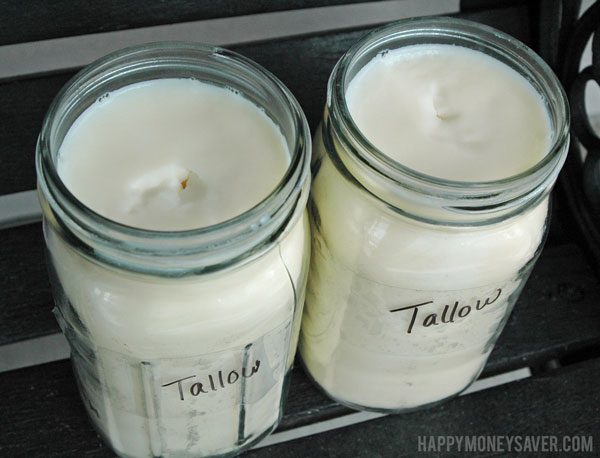
For today’s Happy Homesteading post we are going back in history to learn the long-lost skill of rendering beef tallow fat like many pioneers made & used. Beef tallow was used in cooking as it makes an amazing oil for frying or pastries. They would also use tallow fat for candle making, soap making, moisturizing, keeping cast iron pots from rusting and even for waterproofing leather.
What is Tallow?
“Tallow is the rendered fat of cows, sheep, and other ruminant animals such as deer. It is very solid and waxy at room temperature and can be kept for extended periods without the need for refrigeration. Rendering is the process of gently heating the interior fat tissue, called “suet,” causing the pure oils to melt away from the rest of the tissue.” (Source)Tallow is solid at room temperature, with a texture harder and more waxy than shortening. In fact tallow and lard are rendered the same way, but lard is pig fat slowly melted down and is softer like shortening.
Beef Tallow is a Healthy Fat
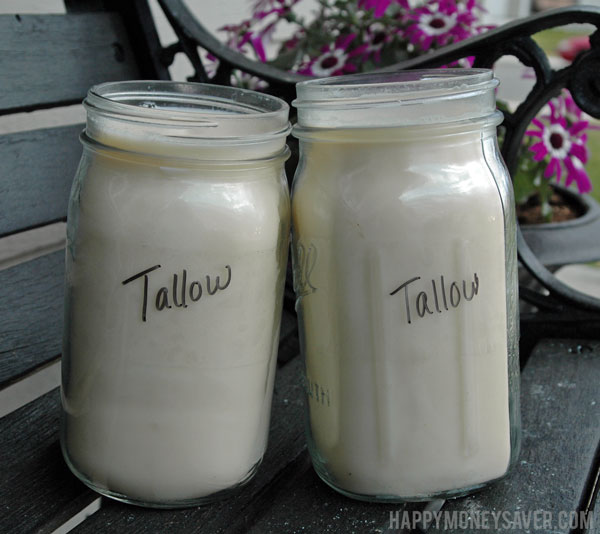
Tallow is the healthy fat that sadly got pushed off the shelves once vegetable oils came around.
Before doing this homesteading series I had honestly never heard of tallow. And when I asked my friends and family about this I just got weird looks. Isn’t it amazing how something that was basically a staple in homes a hundred or two years ago has seemingly been lost or forgotten? After researching I found that beef tallow is actually a very healthy fat full of vitamins and is actually better for you than some of the hydrogenated oils we buy at the stores.
“Tallow is an excellent source of niacin, vitamins B6, B12, K2, selenium, iron, phosphorus, potassium and riboflavin. Grass Fed beef tallow contains high ratio of conjugated linoleic acid (CLA) which is a cancer-resistant agent. Contrary to the popular conception, tallow is good for health as tallow fat is similar to the fat/muscles in the heart. Recent studies have shown that human beings need at least 50% of saturated fats like tallow and lard to keep the heart pumping hale and healthy. Tallow from pasture-raised cows also contains a small amount of Vitamin D, similar to lard. It is also a good source of K2 in its suet form.” (Source)Making Tallow
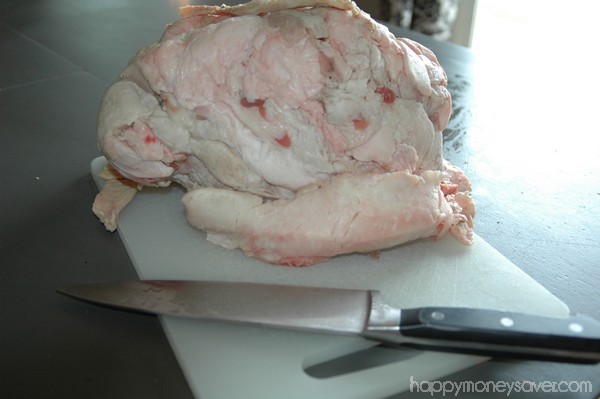
First thing you need is some beef fat. I found a nice local butcher shop, called them up and asked if they had any beef fat. Lucky for me they did and it was only $.67 per lb too. For the nicest and healthiest tallow try to get beef fat from right around the kidneys and preferably from a grass-fed cow. I didn’t ask the butcher at the time I purchased it if this was a grass-fed cow or not, I think I was in shock that I actually found beef fat and that it was so inexpensive. But next time I will ask for sure.
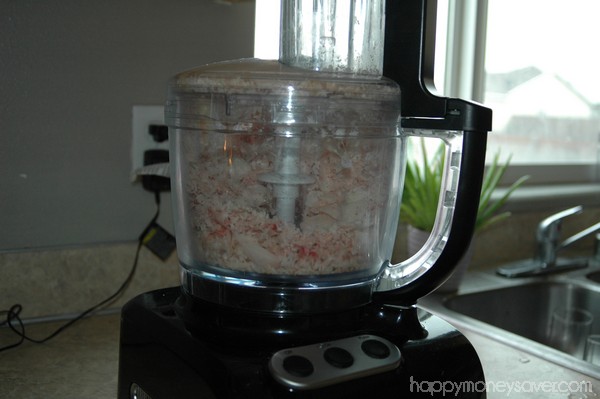
The beef fat I purchased was frozen, so I let it thaw enough that it was still hard but not frozen solid so I could use my food processor to grate it up. If you don’t have a food processor just use a knife and cut the fat into as small of chunks as you can. If there are any pieces of meat you can cut out do it at this stage too.
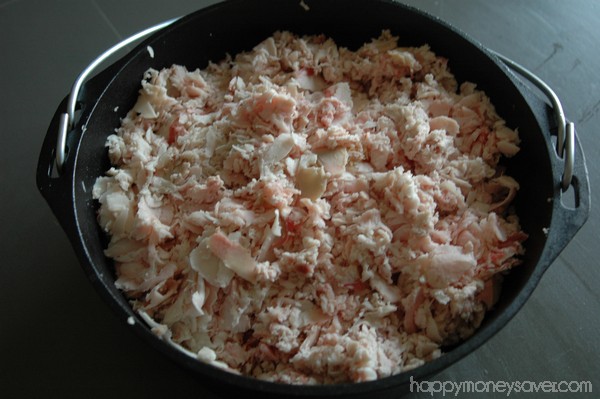
Here is all my beef fat put into my 5 qt. Dutch Oven I purchased. I think there is about 4 lbs of beef fat in there. I filled my pan to the top.
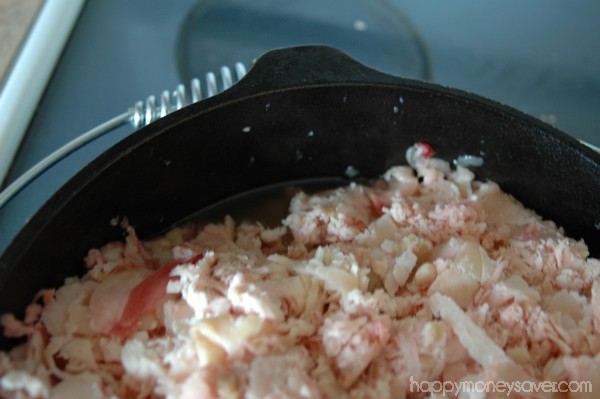
With the heat on low I put the lid on the beef tallow fat and let it start slowly cooking. Here is how it looked after 1 hour. If you had only 1 lb of fat it would look a lot more melted at this stage, but since I have 4 lbs, it is slowly cooking from the bottom.
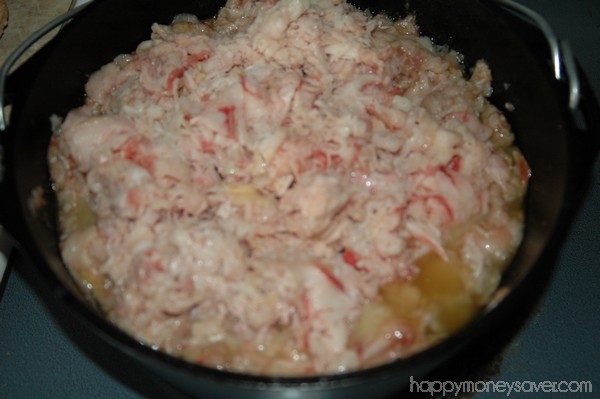
Here it is again after 2 hours. A little more rendered. At this point I took a wooden spoon and mixed the beef tallow fat around a bit. Some people like to take a potato masher and squish it a bit too to help the process along. You don’t want to cook this fast because if it burns it will ruin it all.
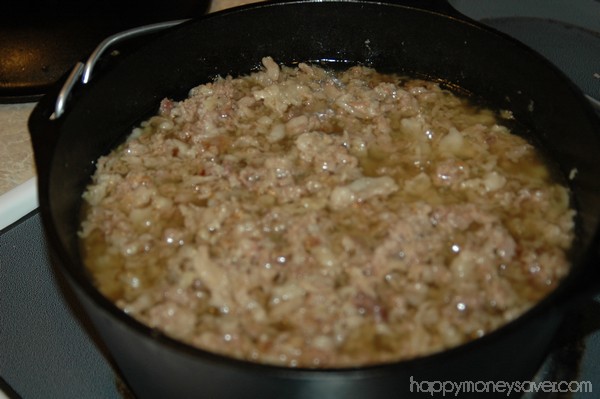
Now its been 4 hours and my house is REALLY starting to smell bad like well..FAT and STINKY OIL. YUCK.

I opened up every window and turned on fans. I can’t stress to you enough how horrible this smelled. At this stage I was just wanting this whole process to be over. I am not kidding. I spent most of the day upstairs just so I couldn’t smell it as much. Then when I did have to go downstairs I actually gagged once from the smell. I am such a baby, aren’t I… 🙂
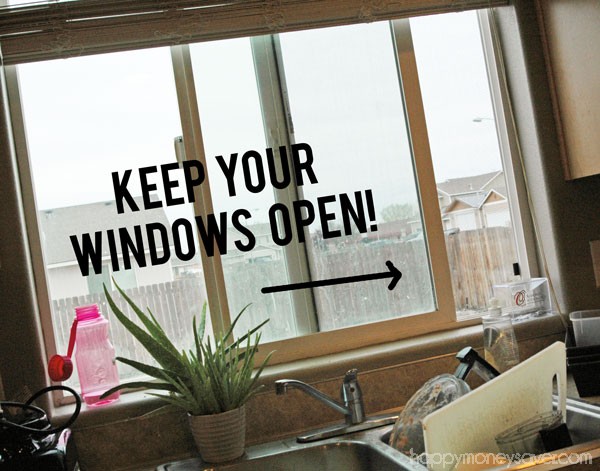
After about 6-7 hours it was all done. You can tell by all the little browned bits cooked till crispy. The Pioneers called these the cracklin’s. They are basically fried bits of meat and grisle. They would sprinkle a little salt on the cracklins and once cool eat them up. I shuddered at the thought after smelling the fat cooking in the air. I actually lost my appetite with the smell in the air.
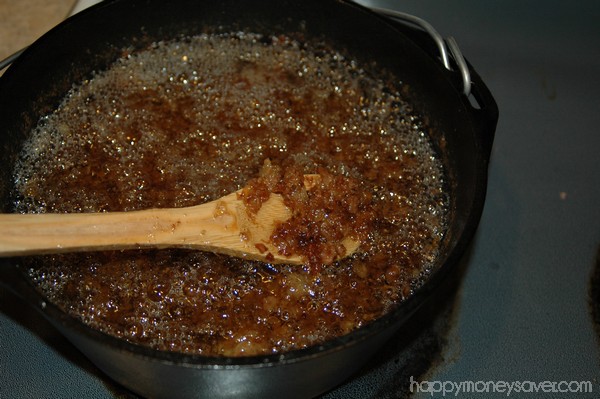
Next is the time to drain all the liquid oil and strain out the cracklin’s. You can use a fine mesh strainer, a paper towel, cheese cloth or what I used: a flour sack towel. I lined the towel over a strainer, which sat over a large bowl.

Then I poured all the hot oil in and strained it. Use oven mitts here, and remember to be safe. This is REALLY HOT oil and can burn you if you are not careful.
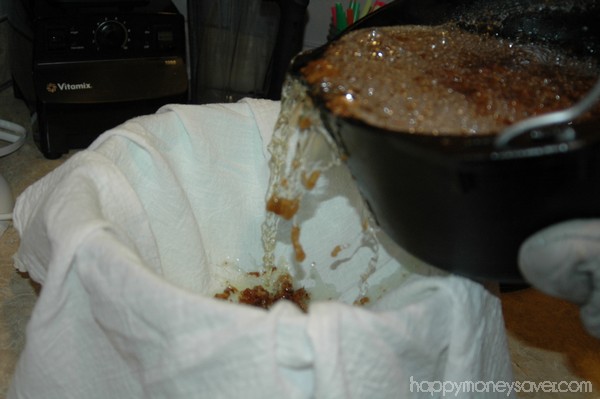
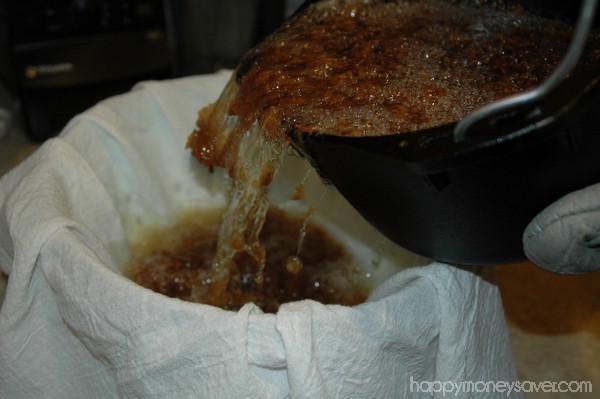

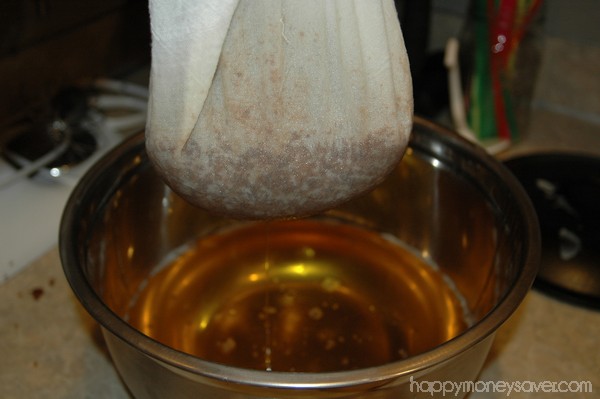
Look at all that lovely yellow liquid tallow left behind after the straining.

It should be a nice yellow color.
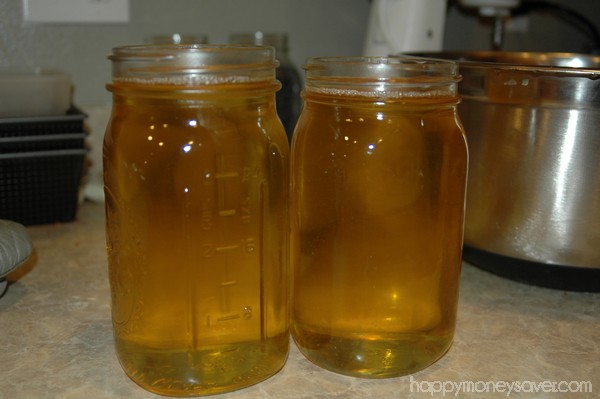
I poured mine into wide mouth glass jars for storage. Then I let it cool all night.
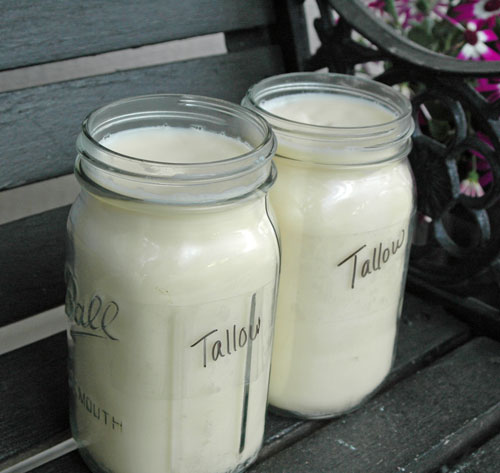
And it turned hard and waxy and white. Isn’t it beautiful??
It was even more beautiful after I deep cleaned my whole kitchen, using vinegar to get the nasty smell out. 😉

Storing Tallow
Beef Tallow is wonderful because as long as you store it in an air-tight container to avoid oxidization it can be at room temperature for up to a year or longer. I have mine in my fridge as it will last even longer there. OR you can pour your tallow fat into ice cube trays and put the frozen cubes into a freezer bag to freeze.
Tallow Soap & Tallow Candles
As many of you might know I made my own homemade soap for the first time last month using a recipe of lye and a variety of store bought oils. I love the soap I made, but I wanted to make soap like the Pioneers and settlers did from long ago using beef tallow. I have heard that homemade tallow soap made from rendering beef tallow is the very best type of soap. It’s strong, its hard and it suds nicely. And I would like to use my own tallow soap instead of using Fels Naptha in my Homemade Laundry Soap recipe as well. So check back, I will be making tallow soap from scratch very soon! Plus I think it might be neat to try to make Tallow candles as well.
So what do you think? Do you have questions? Think this is weird? Please leave a comment with your thoughts!

Ingredients
- Beef Fat preferably from a grass-fed cow and try to get the fat that is from right around the kidneys
Instructions
- Use food processor to grate it up or if you don’t have a food processor just use a knife and cut the fat into as small of chunks as you can.
- If there are any pieces of meat you can cut out do it at this stage too.
- Put beef fat into 5 qt. Dutch Oven, fill pan to the top.
- With the heat on low put the lid on the beef tallow fat and let it start slowly cooking.
- After 2 hours take a wooden spoon and mix the beef tallow fat around a bit. Some use a potato masher and squish it a bit too to help the process along.
- Don’t cook this fast because if it burns it will ruin it all.
- Stir again at about 4 hours.
- After about 6-7 hours it will be done. You can tell by all the little browned bits cooked till crispy.
- Next drain all the liquid oil and strain out the cracklin’s. (Cracklins are basically fried bits of meat and gristle)
- Use a fine mesh strainer, a paper towel, cheese cloth or a flour sack towel and line the towel over a strainer, which should sit over a large bowl.
- Pour all the hot oil in and strain it. It should be a nice yellow color.
- Pour into airtight containers and allow to cool overnight.
- Store it in an air-tight container to avoid oxidization it can be at room temperature for up to a year or longer. You can store it in the fridge as it will last even longer there. OR you can pour your tallow fat into ice cube trays and put the frozen cubes into a freezer bag to freeze.




Comments & Reviews
Mutz says
Hello Kerry,
A friend and myself would be interested in knowing if you can use the fat from ground beef as tallow for cooking, baking and candle making?
With the Covid-19 virus and the big jump in low meat availability and the price of meat going higher, is why we are interested in using fat from less expensive ground beef. We are new to prepping.
Thanks for your help.
Karrie says
Hi Mutz, So I haven’t tried doing it this way, but I can’t see why it wouldn’t work great. One thing to consider doing is to ask your butcher if they have extra fat you can buy for a low cost to make your own tallow. Otherwise, if you want to make it from your ground beef, I’d say cook your ground beef, remove as much of the meat as you can, then continue to slow cook it slowly for several hours like the recipe says to render the fat. Then strain it – if there is liquid still left over since you had so much meat in there it will sink to the bottom and then you can take the tallow off the top after cooling.
Tatyana says
beef fat from butcher or Walmart is much cheaper than the ground beef.
Ildikó says
Thank you for the warning about the smell! I’ll definitely use my grill or roaster outside!
Traci Eaton says
The reeking smell is why my grandma had a laundry stove on the back porch and did this out doors in the fall of the year at butchering time. She did her lard then too.
Amber says
Thank you so much was very easy to follow your instructions. Cant wait to make my own
Karrie says
You bet!! Have fun making tallow!
Bill says
The only weird thing is that you don’t like the smell…when you cook brisket quite a bit renders out and it’s the most beautiful, hunger inducing provocative aroma I know…vinegar makes ME gag
larem says
as an aside. I alternate chicken and beef fat fo cooking. I.e. whatever is available from the ‘fridge. I used to diligently scrape fat from a cut up chicken but now I either collect from stock or from roasting – cooking it down with water and juices from the chicken. That ends up with all the lovely flavours from however you did your roast or stock.. Fab with eggs. I laso once collected and i/2 pint jar of lard just from cooking side pork, but any bacon, if cooked in the oven over a dripping tray can be used.
karen says
I buy marrow and soup bones from a local butcher and if cooked long enought the fat eventuallly separates quite nicely. Not the same as the fat used here but certainly looks identical. wont use for cosmetics as my way will always have a bit of stock not quite rinsed off, but poured into ice cube trays and put in the freezer it is excellent for cooking. do you think it would be OK for soap?
Michael says
Hi, I scrape the marrow out the bones first (with a knife), and then melt it. I haven’t tried making soap, but this way you’d avoid the bone broth element.
Jacqueline Knight says
We are trying our first shot at rendering. We raise to eat our own cows ,Limasine Angus x. We get about 60 to 90 Les per cow. We don’t do grass fed due to time it takes to get to 1000,Les. But we do do all natural feed. We had been leaving far with our processes, I got tired of not keeping what they sell
We keep bones and now fat. Dogs love the bones. I have been doing chicken fried steaks since my boy scout years, now I plan on using the tallow for my grease and gravy. Since we ha e over 100lds in freezer we are cooking down about 25 Les this first goaround. Took your advice , since we are doing so much we’re outside with propane cooker. Thank you for your recipe on the process, finally after all the years of processing our own beef we’re now using all most 95 percent of our animals. Chicken fried steaks on Friday, can’t wait.
Maureen says
Thank-you for the tutorial. We recently purchased a quarter of a steer from our local high school FHA so our fat was FREE…not only that but the other buyers didn’t want it so we got an entire steers worth of soon-to-be tallow! Yippee.
I made the first batch today and I must say, ours smelled heavenly. I even had a friend drop by and ask me what I was making because she loved the aroma coming from the kitchen. Weird.
Jessica says
Hi Maureen, when you made tallow with the fat from the steer, did you only use the fat from around the kidneys? Or other fat as well? I just got a bunch of fat from a neighbors steer and cant seem to find an answer anywhere as to if it’s okay to use fat that wasnt around the kidneys as well?
Tabby says
Thank you for the ideas. We bought a half a grassfed angus bull and he is FAT!
No more fat getting wasted! Yay!
ANNETTE GM POITRAS says
Wonderful. I received some deer tallow from my niece who is a huntress. Since I don’t hunt, I went to the grocery store and asked the butchers there if they sold beef tallow. He said they didn’t but had some beef fat I could have. Thank you for the heads up about the smell. I will render it on my BBQ outdoors. I used the deer tallow in some pain relief cream. Apparently tallow is closest to we humans cell structure therefore is easily absorbed through the skin. Thank you all so much for your comments too. I enjoyed reading them.
Nathan says
Hi karrie great tallow.
I learned this for soap years ago too. I render allot faster than 7 hrs. Like one hour.
After ive done this even if its brown colour i pour it in a pot of water and boil it for an hour.
The tumbling disolves everything in water thats not fat.
Thus clarifying it.
Then freezer til it sets and you pick off the clean slab at the top.
I also clarify old oil the same way.
Then use half and half for deepfrying triple cooked chip wedges.
I started doing this to keep wontons and chips crunchy. even after an hour thyr still crunchy.
I was just guessing that if fat is harder at room temp then water or steam wouldnt make them soggy. Tallow also good for puff pastry. Or half n half butter.
God bless
Nathan.
Joan says
You went to way too much trouble. I just received a big bag of tallow. I just put it in a pot and let it cook all day not messing up my blender. AND I was fortunate enough to find grass-fed beef and had very little smell and after it was cooked I drained the fat and blended what was left will add it to my ground beef since grass-fed beef is lean and dryer
Lori says
Thanks for the smell warning! I think I’ll use an outdoor outlet and leave my slow cooker on the deck out back.
Tapiwa says
Where can I sell this fats
Ms. Common Sense says
I think that isn’t worth it to me to go through all this work and stinkness just to save myself a few cents on the pound. Where I live I can get ready to use tallow from my soap supplier for a mere $11 for 7 pounds!!
Walkerhomestead says
So do that then. What’s the point of your comment?
Alida Gerhart says
Apparently she has not wondered what to do with all the fat that one cuts out of a roast or other pieces of meat. I have just hated to waste it, so I think rendering it into tallow is so economical and makes sense to me, It adds so much to the taste of frying meats, making gravies etc., and it doesn’t cost me a cent.
Cindy says
Wow. You are getting a freaking good deal. All I can find is 7 lbs for $33.00. Where are you at? Or is it a online store?
Marie Shipp says
I just did this but in my Instant pot, one gallon of rendered tallow in one hour with no smell! If you have one try it.
Jacqueline rees-adams says
I just got some beef fat from the butcher, I am going to make Gloucester dripping cakes. This was helpful because I didn’t know about the smell, so I am going to render it in my slow cooker on the patio, I already boil my Brussels and cabbage out there. Works for me
Karrie says
Wonderful! Good luck!
Suz says
Can you do it in the instant pot?
Dustin says
After seeing so many comments and realizing I don’t have the time to read through them all, to find my answer, I’ll just ask…
Since I try to not throw things away as much as possible, I’m curious as to if, and how, you clean your flour sack towel after straining the tallow off from the cracklings.
Karrie says
Hot water and dish soap works wonders!
Rose says
I use waffle-woven rags because they’re reusable and smaller/easier to manage. I just wash by hand with dish soap. Make sure to wash it twice when you used it with something greasy, cause otherwise it might leave a residue. If I happen to have several to wash at once, I wash it with dish soap and washing soda in the washing machine on gentle cycle.
Jon says
I had about 2KG of fat trimmings left over from a whole brisket. Rendering on a low gas burner on the BBQ. No smell, gorgeous cracklin’s and plenty of tallow.
Rose says
Just got done doing the same thing. I did it indoors sand I honestly wasn’t bothered by the smell. ?♀️
I may have burned it slightly, though cause it came out a touch dark, but it cooks up just fine.
I can’t wait to whip up some meat pies with pastry made from it.
Jessica says
I am gonna do this in he summer when I can open the windows. I would do it outside but I don’t want to attract unwanted company. Just got a huge top round slab for a good price. Froze the fat for this later! I might try to make soap with it.
Dylan says
With all the comments I’m sure this will go unoticed , regardless , fat from pasture raised beef is extremely important.